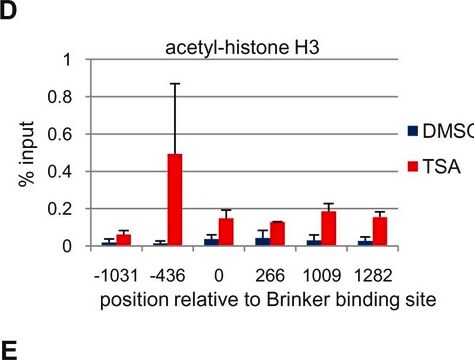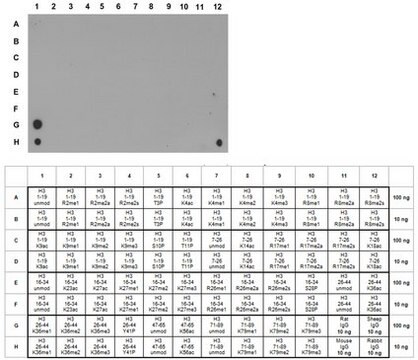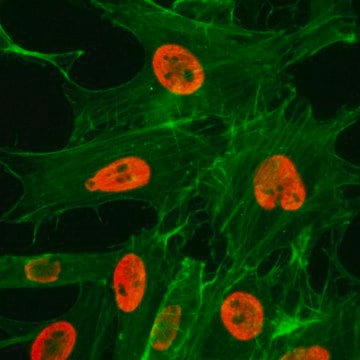04-835
Anti-dimethyl-Histone H3 (Lys79) Antibody, clone NL59, rabbit monoclonal
culture supernatant, clone NL59, Upstate®
Synonym(s):
H3K79me2, Histone H3 (di methyl K79)
About This Item
Recommended Products
biological source
rabbit
Quality Level
antibody form
culture supernatant
antibody product type
primary antibodies
clone
NL59, monoclonal
species reactivity
vertebrates, human
manufacturer/tradename
Upstate®
technique(s)
ChIP: suitable (ChIP-seq)
dot blot: suitable
multiplexing: suitable
western blot: suitable
isotype
IgG
NCBI accession no.
shipped in
dry ice
target post-translational modification
dimethylation (Lys79)
Gene Information
human ... H3F3B(3021)
General description
Specificity
Immunogen
Application
Sonicated chromatin prepared from HeLa cells (1 X 10E6 cell equivalents per IP) were subjected to chromatin immunoprecipitation using either 4 µL of Negative Control Supernatant, or 4 µL of Anti-dimethyl-Histone H3 (Lys79) and the Magna ChIP A Kit (Cat. # 17-610). Successful immunoprecipitation of dimethyl-Histone H3 (Lys79) associated DNA fragments was verified by qPCR using Control Primers
Please refer to the EZ-Magna ChIP A (Cat. # 17-408) or EZ-ChIP (Cat. # 17-371) protocol for experimental details.
Chromatin Immunoprecipitation: A representative lot of this antibody has been shown by an independent laboratory to work in ChIP.
ChIP-Seq Analysis:
A representative lot of this antibody was used by an independent laboratory for ChIP-Seq. See Egelhofer, T.A., et al. (2011). See Easwaran, H., et al. (2012).See Suzuki, H., et al. (2011).
Dot Blotting: Specificity of a representative lot confirmed by the ability of a 1:2500 dilution of the antibody to recognize peptides corresponding to regions of histone H3 with various modifications
Dot Blot Analysis: Absurance Histone H3 Antibody Specificity Array (Cat. No. 16-667) and Absurance Histone H2A, H2B, H4 Antibody Specificity Array (Cat. No. 16-665), which contain histone peptides with various modifications were probed with Cat. No 04-835-S, Anti-dimethyl Histone H3 (Lys79) Antibody, clone NL59 (1:500 dilution). Proteins were visualized using a Donkey anti-rabbit IgG conjugated to HRP and a chemiluminescence detection system.
Epigenetics & Nuclear Function
Histones
Quality
Target description
Linkage
Physical form
Storage and Stability
Handling Recommendations: Upon receipt, and prior to removing the cap, centrifuge the vial and gently mix the solution. Aliquot into microcentrifuge tubes and store at -20°C. Avoid repeated freeze/thaw cycles, which may damage IgG and affect product performance.
Legal Information
Disclaimer
Not finding the right product?
Try our Product Selector Tool.
Storage Class Code
10 - Combustible liquids
WGK
WGK 2
Certificates of Analysis (COA)
Search for Certificates of Analysis (COA) by entering the products Lot/Batch Number. Lot and Batch Numbers can be found on a product’s label following the words ‘Lot’ or ‘Batch’.
Already Own This Product?
Find documentation for the products that you have recently purchased in the Document Library.
Our team of scientists has experience in all areas of research including Life Science, Material Science, Chemical Synthesis, Chromatography, Analytical and many others.
Contact Technical Service








